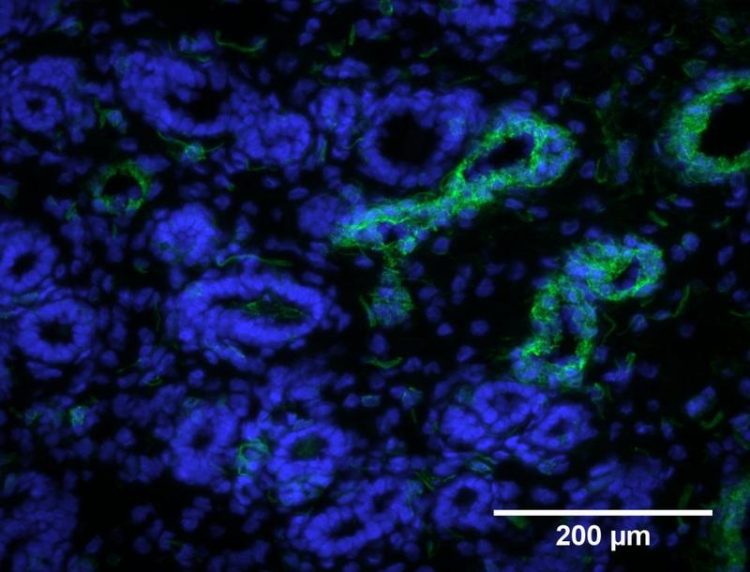New insights could lead to lasting improvement of stem cell therapy in horses

Equine endometrium by fluorescence microscope analysis, stem cells (green coloured) were identified using a stem cell marker; Elisabeth Rink/Vetmeduni Vienna
Mesenchymal stem cells are multipotent cells found in a number of tissues that can differentiate into various cell types. Stem cells thus provide an enormous potential for regenerative medicine. Such progenitor cells have been used clinically for about 15 years to treat several tendon and joint conditions in horses.
Until now, the stem cells needed for therapeutic purposes have usually been harvested surgically from the animals’ bone marrow or fat tissue. Researchers from the Centre for Artificial Insemination and Embryo Transfer at Vetmeduni Vienna have now succeeded for the first time in harvesting stem cells from the uterus of horses. The procedure requires no surgical intervention and the laboratory results show that the cells differentiate into cartilage and other tissues.
Uterine stem cells harvested without surgery
Unlike bone marrow or fat tissue, the uterus can be accessed non-surgically using small instruments inserted via the cervix. The harvest of mesenchymal stem cells from the endometrium, the mucous membrane of the uterus, could therefore contribute to a reduction of surgical and invasive experiments in animals.
“While the human endometrium is known to harbour stem cells, these had previously not been identified in equine endometrium,” say Elisabeth Rink and Christine Aurich from the Centre for Artificial Insemination and Embryo Transfer at Vetmeduni Vienna.
The two researchers, in an international team with Xavier Donadeu from the Roslin Institute at the University of Edinburgh and Hilari French from Ross University School of Veterinary Medicine in Saint Kitts and Nevis, have now managed to confirm the presence of stem cells in the endometrial tissue of horses. The data on the isolation, culture and characterization of mesenchymal stem cells from the equine endometrium was published in the journal Stem Cell Research and Therapy.
Extended options for stem cell therapy in horses
For the study, uterine tissue samples were collected from six mares. The team then separated suspected stem cells from endometrial epithelial cells and expanded these in cell culture. The isolated cells were then identified as potential stem cells using various molecular biology techniques.
“The laboratory analyses, such as immunohistochemistry, genetic analysis and flow cytometry, aimed to identify the stem cells through specific cell markers, i.e. the expression of genes and the presence of certain surface proteins,” explains first author Elisabeth Rink. For comparison with the endometrial cells, stem cells obtained from the bone marrow by traditional surgical techniques were analysed in the same way.
Cells obtained from the uterus clearly expressed the same markers as bone marrow stem cells. Furthermore, the scientists were able to show in cell culture conditions that the endometrial stem cells differentiated into fat, bone, cartilage and muscle cell lines.
“The endometrium provides a source of mesenchymal stem cells that can be easily accessed with little stress to the animals. The cell culture results show that these cells can be of benefit not only in the treatment of uterine conditions, but that they can also replace the need for surgically obtained stem cells for therapeutic purposes in other tissue types,” concludes senior researcher Christine Aurich.
Service:
The article „Isolation and characterization of equine endometrial mesenchymal stromal cells“ by B. Elisabeth Rink, Karin R. Amilon, Cristina L. Esteves, Hilari M. French, Elaine Watson, Christine Aurich and F. Xavier Donadeu was published in Stem Cell Research and Therapy.
https://stemcellres.biomedcentral.com/articles/10.1186/s13287-017-0616-0
About the University of Veterinary Medicine, Vienna
The University of Veterinary Medicine, Vienna in Austria is one of the leading academic and research institutions in the field of Veterinary Sciences in Europe. About 1,300 employees and 2,300 students work on the campus in the north of Vienna which also houses five university clinics and various research sites. Outside of Vienna the university operates Teaching and Research Farms. The Vetmeduni Vienna plays in the global top league: in 2017, it occupies the excellent place 8 in the world-wide Shanghai University veterinary in the subject “Veterinary Science”. http://www.vetmeduni.ac.at
Scientific Contact:
Christine Aurich
Insemination and Embryotransfer Platform
University of Veterinary Medicine Vienna (Vetmeduni Vienna)
T +43 1 25077-6400
christine.aurich@vetmeduni.ac.at
Elisabeth Rink
Insemination and Embryotransfer Platform
University of Veterinary Medicine Vienna (Vetmeduni Vienna)
T +43 1 25077-5432
elisabeth.rink@vetmeduni.ac.at
Released by:
Georg Mair
Science Communication / Corporate Communications
University of Veterinary Medicine Vienna (Vetmeduni Vienna)
T +43 1 25077-1165
georg.mair@vetmeduni.ac.at
http://www.vetmeduni.ac.at/en/infoservice/presseinformation/press-releases-2017/…
Media Contact
All latest news from the category: Life Sciences and Chemistry
Articles and reports from the Life Sciences and chemistry area deal with applied and basic research into modern biology, chemistry and human medicine.
Valuable information can be found on a range of life sciences fields including bacteriology, biochemistry, bionics, bioinformatics, biophysics, biotechnology, genetics, geobotany, human biology, marine biology, microbiology, molecular biology, cellular biology, zoology, bioinorganic chemistry, microchemistry and environmental chemistry.
Newest articles

First-of-its-kind study uses remote sensing to monitor plastic debris in rivers and lakes
Remote sensing creates a cost-effective solution to monitoring plastic pollution. A first-of-its-kind study from researchers at the University of Minnesota Twin Cities shows how remote sensing can help monitor and…

Laser-based artificial neuron mimics nerve cell functions at lightning speed
With a processing speed a billion times faster than nature, chip-based laser neuron could help advance AI tasks such as pattern recognition and sequence prediction. Researchers have developed a laser-based…

Optimising the processing of plastic waste
Just one look in the yellow bin reveals a colourful jumble of different types of plastic. However, the purer and more uniform plastic waste is, the easier it is to…



